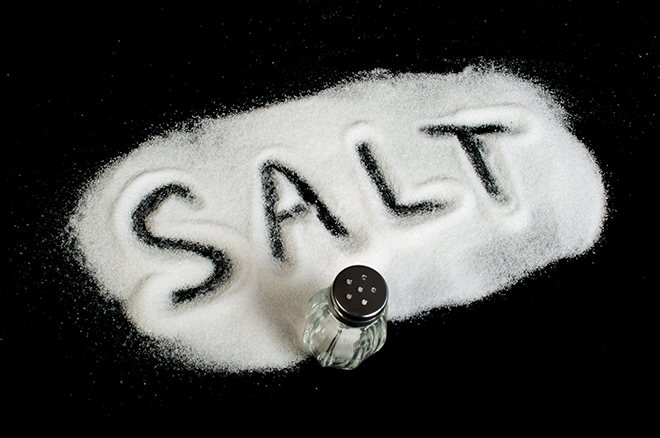Excess salt consumption raises blood pressure, which increases the risk of heart attacks, heart failure and stroke. A diet high in salt is also linked to other conditions such as kidney problems/stones, fluid retention, and osteoporosis. Worldwide excess salt intake is estimated to cause about three million deaths each year.
To reduce the risk of high blood pressure and lower the risk of heart disease, the World Health Organisation (WHO) recommends that adults consume less than 5 g of salt a day. That amount equals about 1 teaspoon per day but global daily average salt intakes are 14 g/day. Amongst Norwegian adults, the estimated average salt intake is 10 g/day in men and 8 g/day in women.
Salt in food
Salt in food gives us that highly sought after, lip-smacking taste that makes food enjoyable and less bland. Approximately 75% of the salt we consume comes from processed foods such as bread and bakery products, processed meats, cheese, sauces and dressings so salty foods can be difficult to avoid. However, there are some ways we can limit the amount of salt we consume.
Five tips to reduce salt intake
1. Use salt alternatives
When we regularly eat salty foods, we develop a taste for it. The good news is we don’t have to cut out salt all at once. A gradual reduction in the amount of salt consumed each day, will lead to our taste buds adjusting in a few weeks. When this happens, we start to notice other flavors that salt was hiding and over time, the enjoyment gained from eating salty foods will decline. This is a great opportunity to experiment with different flavors and use salt alternatives such as lemon juice, garlic, vinegar or herbs and spices.
2. Check the label
In addition to the Keyhole symbol, which acts as a sign of healthier foods, also look at the Nutrition Information Panel to find out how much salt is in a food product. Salt is listed as sodium. Use the ‘per 100g’ column and aim for foods with less than 400 mg per 100g of product.
3. Cook at home
Preparing and cooking food at home is a good way to reduce salt as we can control how much salt is added and can choose ingredients reduced in salt. Between <25% to >50% of dietary salt comes from salt added at the table or during cooking so it’s important to think about the salt shaker too.
4. Stick to fresh food where possible
Include a wide variety of fruit and vegetables, plain meat, poultry and fish, plain unsalted nuts and legumes and lentils in your diet. Try adding healthier lunch box options such as boiled eggs, salad and fresh fruit pieces.
5. Reduce salty foods
High levels of salt are often added to packet soups and sauces, canned fish, sausages, and frozen meals. Stock cubes, soy sauce, Asian-style sauces, tomato sauce and mayonnaise are also often highly salted.
Try to limit takeaway and fast foods such as burgers, fried chicken and pizza. Limiting salty snacks like chips, pretzels and crackers will also help cut down salt.
Remember too, that eating a few salty foods over the day, can easily lead to daily intakes over the recommendation. For example, salt is found in bread, cheese and processed meats, which means a regular ham and cheese sandwich, can pack a sodium punch. Choosing fresh foods, and lower salt versions of your favorite products all helps to lower the amount of salt you are eating.
Read more:
- Helsedirektoratet Salt and the Salt Partnership https://www.helsedirektoratet.no/english/salt-and-the-salt-partnership#saltreduction-is-an-international-goal
- World Action on Salt and Health http://www.worldactiononsalt.com/research/





